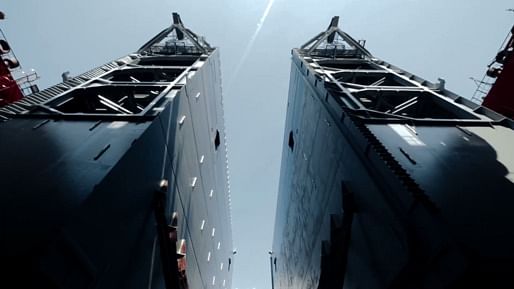

Over a hundred years ago, the first ships passed from the Atlantic to the Pacific through the Panama Canal. One of the greatest engineering feats ever, the Panama Canal is entering a new stage in its history in order to stave off the threat of obsolescence presented by “post-Panamax” ships, or vessels larger than the size constraints of the Canal. An engaging episode of the History Channel’s Modern Marvels series, “Panama Canal Supersized” documents the herculean efforts of engineers and thousands of workers to construct a new passage through the Americas that will radically change the global economy.

Considered one of the seven wonders of the modern world by the American Society of Civil Engineers, the original Panama Canal took over a decade to complete. Since the early 16th century, there were several attempts to cut through the American continent in order to facilitate faster trade, eventually leading to a failed effort by the French in the late 19th century. The United States picked up where the French left off and in 1914 the Canal finally opened, costing the U.S. government some $375,000,000 (roughly equivalent to $8,600,000,000 now). When it opened, annual traffic was about 1,000 ships; in 2008, 14,702 vessels passed through the nearly century-old gates. Basically, much of global trade has revolved for a hundred years around the capacity of the Panama Canal. But, with the invention of post-Panamax vessels, the Canal needed an upgrade.

The documentary, produced by Radiant Features, includes stunning footage of the Panama Canal expansion project. As one engineer notes, “This whole project has been a series of biggest and bests.” A massive channel had to be excavated, involving removing hard rocks on the Pacific side while on the Atlantic site, workers had to deal with soft soil and the region’s torrential, seven-month long rainy season. The massive walls of the new canals required enough steel to build 18 Eiffel Towers. There is twice the amount of concrete in the Pacific and Atlantic locks than in the Hoover Dam. And the chambers used to bring water to fill the locks are long enough to fit the Empire State Building.

“Panama Canal Supersized” is a captivating ride through a project of near-impossible scope. With sweeping aerials and wide-angles, the filmmakers represent both the difficulties of the task and linger on the brutalist beauty of the concrete forms. One of the most engaging segments documents the manufacturing and transportation of the Canal’s giant gates from Italy to Panama. As much as the project will transform the global economy – and the documentary notes at the end how ports around the world are already engaging in renovations to accommodate the bigger ships that will now pass through the Canal – it is also a result of this globalized network.

There is less focus on the ecological impact of the project, although that isn’t really a fault for a 45-minute long feature devoted to engineering. The project and the footage is so impressive that it requires at least that much time. Still, as mountains are – quite literally – moved, the radical capacity of humans to reshape geography is equal parts startling and awe-inspiring to watch.
Don’t miss “Panama Canal Supersized,” premiering April 11 at 9PM on the History Channel.

No Comments
Block this user
Are you sure you want to block this user and hide all related comments throughout the site?
Archinect
This is your first comment on Archinect. Your comment will be visible once approved.